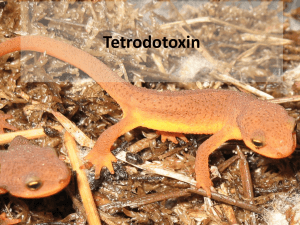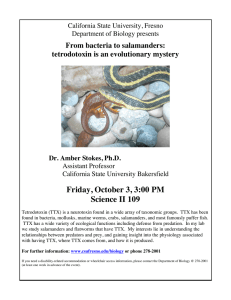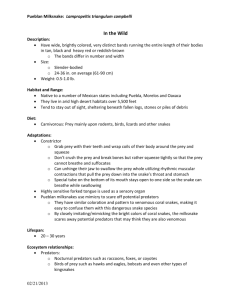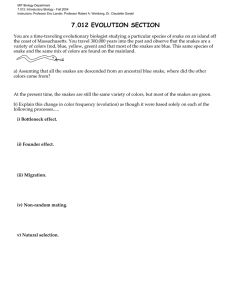Tetrodotoxin affects survival probability of rough-skinned newts
advertisement
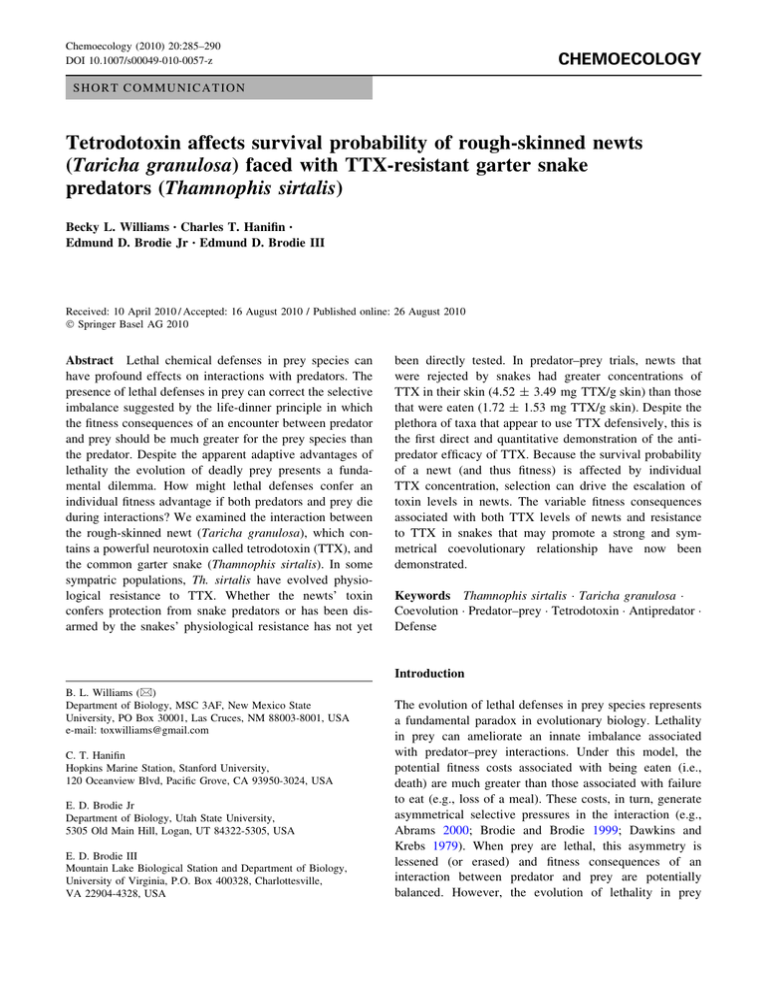
Chemoecology (2010) 20:285–290 DOI 10.1007/s00049-010-0057-z CHEMOECOLOGY SHORT COMMUNICATION Tetrodotoxin affects survival probability of rough-skinned newts (Taricha granulosa) faced with TTX-resistant garter snake predators (Thamnophis sirtalis) Becky L. Williams • Charles T. Hanifin • Edmund D. Brodie Jr • Edmund D. Brodie III Received: 10 April 2010 / Accepted: 16 August 2010 / Published online: 26 August 2010 Ó Springer Basel AG 2010 Abstract Lethal chemical defenses in prey species can have profound effects on interactions with predators. The presence of lethal defenses in prey can correct the selective imbalance suggested by the life-dinner principle in which the fitness consequences of an encounter between predator and prey should be much greater for the prey species than the predator. Despite the apparent adaptive advantages of lethality the evolution of deadly prey presents a fundamental dilemma. How might lethal defenses confer an individual fitness advantage if both predators and prey die during interactions? We examined the interaction between the rough-skinned newt (Taricha granulosa), which contains a powerful neurotoxin called tetrodotoxin (TTX), and the common garter snake (Thamnophis sirtalis). In some sympatric populations, Th. sirtalis have evolved physiological resistance to TTX. Whether the newts’ toxin confers protection from snake predators or has been disarmed by the snakes’ physiological resistance has not yet been directly tested. In predator–prey trials, newts that were rejected by snakes had greater concentrations of TTX in their skin (4.52 ± 3.49 mg TTX/g skin) than those that were eaten (1.72 ± 1.53 mg TTX/g skin). Despite the plethora of taxa that appear to use TTX defensively, this is the first direct and quantitative demonstration of the antipredator efficacy of TTX. Because the survival probability of a newt (and thus fitness) is affected by individual TTX concentration, selection can drive the escalation of toxin levels in newts. The variable fitness consequences associated with both TTX levels of newts and resistance to TTX in snakes that may promote a strong and symmetrical coevolutionary relationship have now been demonstrated. Keywords Thamnophis sirtalis Taricha granulosa Coevolution Predator–prey Tetrodotoxin Antipredator Defense Introduction B. L. Williams (&) Department of Biology, MSC 3AF, New Mexico State University, PO Box 30001, Las Cruces, NM 88003-8001, USA e-mail: toxwilliams@gmail.com C. T. Hanifin Hopkins Marine Station, Stanford University, 120 Oceanview Blvd, Pacific Grove, CA 93950-3024, USA E. D. Brodie Jr Department of Biology, Utah State University, 5305 Old Main Hill, Logan, UT 84322-5305, USA E. D. Brodie III Mountain Lake Biological Station and Department of Biology, University of Virginia, P.O. Box 400328, Charlottesville, VA 22904-4328, USA The evolution of lethal defenses in prey species represents a fundamental paradox in evolutionary biology. Lethality in prey can ameliorate an innate imbalance associated with predator–prey interactions. Under this model, the potential fitness costs associated with being eaten (i.e., death) are much greater than those associated with failure to eat (e.g., loss of a meal). These costs, in turn, generate asymmetrical selective pressures in the interaction (e.g., Abrams 2000; Brodie and Brodie 1999; Dawkins and Krebs 1979). When prey are lethal, this asymmetry is lessened (or erased) and fitness consequences of an interaction between predator and prey are potentially balanced. However, the evolution of lethality in prey 286 superficially appears paradoxical because there is no individual advantage to ‘‘lethal’’ defenses if both prey and predators die during a predatory interaction (e.g., Brodie 2010; Brodie and Brodie 1999). This apparent puzzle can be explained through kin selection in some cases (e.g., Benson 1971; Fisher 1930; Ruxton and Sherratt 2006), or through individual selection when mechanisms exist to allow escape from the full consequences (death) of the interaction (e.g., Ruxton and Sherratt 2006). Taste-rejection is one of many mechanisms used by predators to abate lethal consequences (e.g., Skelhorn and Rowe 2006), and individual prey may survive such sampling. For example, individual toxic insect larvae may survive ‘‘tasting’’ by various bird predators (e.g., Exnerová et al. 2006; Järvi et al. 1981; Wiklund and Järvi 1982), and some ascidian, coral, sponge, gorgonian, hydroid, and bryozoan larvae survive ‘‘tasting’’ by fish, coral, and anenome predators (e.g., Lindquist 1996; Young and Bingham 1987). Newts of the genus Taricha possess tetrodotoxin (TTX) and related analogs (reviewed by Hanifin 2010), which block ion conductance through voltage-gated sodium channels (e.g., Nav1.4; Kao and Levinson 1986; Hille 2001). Despite the fact that other predators such as birds and fish succumb to the newts’ deadly neurotoxin (e.g., Brodie 1968; McAllister et al. 1997; Mobley and Stidham 2000), at least three species of gartersnakes (Thamnophis sirtalis, Th. couchi, and Th. atratus) circumvent this defense and consume all four species of newts (Taricha granulosa, Ta. torosa, Ta. rivularis, and Ta. sierrae; e.g., Brodie 1968; Brodie and Brodie 1990; Brodie et al. 2005; Edgehouse 2008; Feldman et al. 2009; Greene and Feldman 2009; Gregory and Nelson 1991; Twitty 1966; Williams et al. 2004; Wiseman and Pool 2007). Resistance in snakes occurs through modifications of the amino acid sequence at the channel pore that decrease the binding affinity for the TTX molecule (Feldman et al. 2009; Geffeney et al. 2002, 2005). Thus, the impairment of action potentials in nerve and muscle tissue, which eventually leads to asphyxiation and death in susceptible organisms (Kao 1966), is greatly reduced in resistant snakes. Snakes with high individual resistance are more likely to survive interactions with and successfully consume the otherwise deadly newts (Williams et al. 2003). Presumably, an assessment of resistance is made relative to newt toxicity; however, a non-destructive individual assay for newt TTX levels was not available at the time of that experiment (Williams et al. 2003). Thus, fitness (or survival as the proxy thereof) varies with respect to predator exploitive abilities (resistance), but whether prey defenses likewise affect prey fitness is unknown. Here, we directly test whether newt TTX levels affect newt survival probability. B. L. Williams et al. Materials and methods Only empirical tests with predators and prey that interact ecologically can demonstrate the realized antipredator efficacy of a defensive trait. Thus, we tested antipredator efficacy of TTX in Benton Co., OR, where snake predators (Th. sirtalis) are known to consume newts (Ta. granulosa; Brodie and Brodie 1990; Williams et al. 2004). Adult Ta. granulosa and Th. sirtalis were collected during the spring and summer of 1998–2000. Animals were housed at Utah State University with a 14:10 light–dark cycle. Snakes were maintained at an ambient temperature of 24°C and offered a thermal gradient (24–30°C), a moist hide box, fresh water, and weekly fish meals. Newts were housed at 14°C in filtered water and fed crickets and worms weekly. Assaying TTX levels in newts Newt TTX content was assessed via comparison to a commercial standard with high performance liquid chromatography (HPLC). Our methods were the same as Williams et al. (2004), which were a modification of methods previously reported (Hanifin et al. 1999; Yotsu et al. 1989), with the following exceptions. A small section (*1 9 2 mm) of newt skin mid-dorsum was removed from anesthetized animals prior to feeding trials and weighed to the nearest 0.001 g and extracted as per the methods of Williams et al. (2004) for newts. Parameters and equipment for HPLC quantification were the same as in Williams et al. (2004). Concentration of TTX in the skin was reported in mg TTX per g skin. Mean concentrations of TTX in the skin that were consumed versus those that were rejected were compared with t tests. Newt TTX concentrations were regressed on newt mass via ANOVA. Assaying TTX resistance in snakes Resistance of snakes to TTX also affects predator–prey interactions between snakes and newts (Williams et al. 2003). Thus, we assessed resistance to confirm that it did not vary between our treatment groups and confound the effect of newt TTX concentration on newt survival. Resistance was assessed by the methods of Brodie and Brodie (1990) as data were collected for other ongoing projects (Brodie et al. 2002; Hanifin et al. 2008). Briefly, snake crawl speed is reduced after an intraperitoneal injection of TTX and this reduction, expressed as a percentage, offers a quantitative measure of resistance. Snakes with high resistance may crawl at 100% of their original crawl speed whereas snakes with low resistance crawl only at a small percentage of their original speed or not at all (resistance = 0%). During this experimental period, the amount of TTX necessary to assess resistance in adult TTX affects survival probability of rough-skinned newts snakes was prohibitive. Thus, resistance was directly assessed in five adult snakes but assessed indirectly for eight females that bore litters. Because resistance is heritable (h2 = 0.65-0.80; Brodie and Brodie 1990, 1991), we estimated these eight females’ resistance as simply the mean resistance of their offspring. We did not assess resistance in seven of the snakes. We tested whether groups of snakes that either rejected or consumed newts differed in resistance with a t test. Assaying predator–prey interactions in snakes and newts Gravid females may forgo feeding late in gestation. The majority of snakes used in this study were female, but were not gravid. All the snakes were consuming weekly meals of fish regularly and to satiation before commencement of this experiment. Previous to behavioral trials, snakes’ weekly offering of fish was withheld. Thus, snakes were deprived of food for 8–13 days before testing. During feeding trials, an adult newt was introduced into an adult snake’s home enclosure. Newt size was qualitatively matched to snake size to emphasize whether rejection or consumption was based on newt TTX levels rather than relative size of predator and prey. The assumption of equal size ratios between snakes that either ate or rejected newts was examined after behavioral trials with a t test. Because we were primarily interested in the outcome of the predation sequence after contact, each newt was placed within the visual field of a snake. When snakes oriented toward the newt, the newt was released and the predation sequence progressed without further observer interference. The observation was terminated when newts had been consumed, as determined by the snake closing its mouth after the newt had moved down the gullet, or when a snake had rejected a newt as determined by a strike, consequent release of the newt, and no further strikes for a period of 5 min. All snakes struck at newts and were thus presumably hungry. We measured snake and newt mass to the nearest 0.01 g. Newts were measured immediately preceding feeding trials, while snakes were measured post-feeding to minimize disturbance before behavioral trials. Snake mass was estimated for snakes that had consumed a newt by subtracting the newt mass from the total mass of the snake with a newt bolus. Results During 20 predator–prey trials, each with different individual snakes and newts, 11 newts were rejected and 9 were consumed. Those rejected had higher concentrations 287 of TTX in the skin on average (mean ± SD = 4.523 ± 3.485 mg TTX/g skin) than those that were eaten (1.722 ± 1.531 mg TTX/g skin; t = 2.232, df = 18, p = 0.019; Table 1; Fig. 1). One rejected newt possessed an extremely high TTX concentration (12.817 mg TTX/g skin) and appears to be an outlier (Fig. 1). However, removal of this data point did not affect the statistical conclusion that rejected newts possessed higher TTX concentration than those consumed (t = 2.201, df = 17, p = 0.021). In addition, this concentration is still congruent with TTX amounts in other published accounts of this population (Hanifin et al. 2004); thus, we have no reason to doubt the authenticity of this data point and it was not removed from our dataset. Snake size relative to newt size did not vary between groups that consumed versus those that did not consume newts (t = 0.881, df = 18, p = 0.195), nor did resistance differ for the subsample of 13 snakes for which we had data (7 newts rejected, 6 consumed by these snakes; t = 0.998, df = 11, p = 0.170). Thus, because we controlled for size and resistance of snakes we were able to directly test the effect of TTX concentration on newt survival probability. Discussion The concentration of TTX in newt skin affects newt survival probability in interactions with resistant predators. Selection on newt TTX levels requires variation in predator–prey outcomes that depends on variation in TTX levels of individual newts. A fundamental paradox associated with lethal defenses, like TTX, in prey species is how selection acts if an individual dies as a result of delivering its toxin load during a predator–prey interaction. Here we demonstrate a mechanism to explain variable fitness consequences associated with TTX levels of newts in relationship to predation by TTX resistant garter snakes. Snakes mitigate the consequences of attempted ingestions of TTX-bearing newts by behaviorally rejecting newts with high TTX levels (this paper, Williams et al. 2003). Thus, TTX concentration in newt skin is an effective defense. Despite the plethora of taxa that possess TTX and presumably employ it defensively (e.g., Williams 2010), this is the first direct demonstration that survival probability of any organism depends on the quantity of TTX they possess when faced with a natural predator. However, note that approximately one-third of populations tested are mismatched with snake resistance exceeding newt TTX levels (Hanifin et al. 2008). In these populations we expect the effect of newt TTX levels to be inconsequential on the probability of newt consumption by garter snakes. Another factor that should influence outcome of interactions between snakes and newts is the relative size of 288 Table 1 Outcome of predator– prey trials between individual newts (Taricha granulosa) and snakes (Thamnophis sirtalis) Newt mass, the concentration of tetrodotoxin (TTX) in each newt’s skin, snake mass, and snake resistance to TTX in mouse adjusted mass units (MAMUs; see text) are given NE not examined, n/a not applicable a Resistance was assessed for individual snakes (n = 5) or estimated by mean resistance of the snake’s litter (n = 8) where possible B. L. Williams et al. Outcome Newt mass (g) TTX conc. (mg TTX/g skin) Consumed 13.5 0.00 Consumed 21.0 Consumed 11.2 Snake mass (g) Resistance (%) Litter size 98.3 28a 6 0.40 115.7 NE n/a 0.54 110.3 NE n/a a Consumed 13.2 0.81 102.0 32 22 Consumed 24.8 1.41 149.0 10a 8 Consumed 16.8 1.60 101.8 NE n/a Consumed 13.4 2.68 85.4 15a 15 Consumed 16.9 3.76 117.4 40a 19 a 19 Consumed 18.4 4.29 130.8 38 Rejected 11.6 0.68 91.6 20 n/a Rejected Rejected 18.0 17.7 1.61 1.65 108.1 95.6 70a 57a 11 9 Rejected 11.8 2.31 84.6 23 n/a Rejected 12.2 2.96 131.9 27 n/a Rejected 9.3 3.44 76.2 30 n/a Rejected 5.3 4.98 88.9 NE n/a Rejected 12.7 5.69 70.2 NE n/a Rejected 11.7 6.24 70.1 NE n/a Rejected 20.5 7.38 106.6 NE n/a Rejected 8.9 12.82 85.5 27 n/a Fig. 1 Tetrodotoxin (TTX) levels of newts (Taricha granulosa) either rejected or consumed by garter snake predators (Thamnophis sirtalis). Error bars (SE) and mean (horizontal bar) are depicted predators to prey. Once a prey item reaches a threshold maximum or minimum size (relative mass or prey diameter to gape size), the probability of consumption declines to zero (reviewed by Arnold 1993). Although newt TTX stores are marginally a function of newt size, and juveniles are much less toxic than adults, extensive individual variation in TTX levels swamps the effect of size in adults and no correlation between newt TTX levels and size emerges within populations (Brodie et al. 2005; Hanifin et al. 1999; 2004). As expected, there was also no apparent relationship between TTX concentration and newt size in this study. However, newt size presumably also interacts with newt TTX concentration by influencing deliver rate of TTX. Because TTX is water soluble and absorbed rapidly though the mucosa while swallowing newt prey (Williams et al. 2003), the rate of TTX uptake and thus intoxication should increase as swallowing time increases. Ingestion of prey near the minimum or maximum size thresholds is inefficient (e.g., Pough and Groves 1983; Jayne et al. 1988; Mori 2006; Shine 1991); i.e., relatively larger prey items take longer to consume, thus increasing a snake’s exposure time and accelerating intoxication when dealing with dangerous prey. In this study we controlled for size as well as snake resistance to directly assess the effect of concentration of TTX in newt skin to predator–prey outcomes. However, we did not quantitatively size match or assess resistance a priori for all snakes. Although there was no statistical difference between snake size and resistance between groups of snakes that either rejected or consumed a newt, which allowed us to directly assess the effect of TTX concentration, we may not have removed all variance in predator–prey outcomes due to these factors in this experiment. Resistance (Williams et al. 2003) and TTX concentrations (this study) will not solely determine the outcome of TTX affects survival probability of rough-skinned newts individual predator–prey interactions. Clearly there is extensive variation in the outcome of predator–prey interactions between snakes and newts such that at times snakes will reject newts of low toxicity (Fig. 1). In addition, snakes of very low resistance are still at risk of death if they fail to quickly and accurately reject newts that exceed their TTX tolerance (Williams et al. 2003). Even snakes from populations of the lowest resistance when repeatedly offered newts from populations of elevated toxicity do not appear to learn to avoid these dangerous prey items (BLW, unpubl. data). Thus, errors in snake assessment of newt toxicity can occur at either end of the spectrum—on occasion snakes will fail to reject newts with TTX levels that are too high (and suffer lethal consequences; Williams et al. 2003) and likewise, at times, reject newts that could have been palatable based strictly on TTX levels relative to resistance. Evolutionarily, the latter error should be less costly. Acknowledgments This research was supported by the National Science Foundation NSF-DEB 9796291 & 9903829 to E. D. Brodie III, NSF-DEB 9521429 & 9904070 to E. D. Brodie, Jr., a Sigma Xi Grant in Aid of Research to B. L. Williams, and the Gaige Award from the American Society of Ichthyologist and Herpetologists (ASIH) to B. L. Williams. This research was approved by the Utah State University Institutional Animal Care and Use Committee (IACUC protocol number 1008). Voucher specimens were deposited in the University of Texas at Arlington’s Collection of Vertebrates. We thank J. E. Motychak, D. G. Mulcahy, and B. J. Ridenhour, and I. M. Asmundsson for assistance in the collection of animals. Collecting permits were provided by the Oregon Department of Fish and Wildlife. References Abrams PA (2000) The evolution of predator–prey interactions: theory and evidence. Annu Rev Ecol Syst 31:79–105 Arnold SJ (1993) Foraging theory and prey-size–predator-size relations in snakes. In: Seigal RA, Collins JT (eds) Snakes: ecology and behavior. McGraw-Hill, USA, pp 87–115 Benson WW (1971) Evidence for the evolution of unpalatability through kin selection in the Heliconiinae. Am Nat 105:213–226 Brodie ED Jr (1968) Investigations on the skin toxin of the adult rough-skinned newt, Taricha granulosa. Copeia 1968:307–313 Brodie ED III (2010) Convergent evolution: pick your poison carefully. Curr Biol 20:R152–R154 Brodie ED III, Brodie ED Jr (1990) Tetrodotoxin resistance in garter snakes: an evolutionary response of predators to dangerous prey. Evolution 44:651–659 Brodie ED III, Brodie ED Jr (1991) Evolutionary response of predators to dangerous prey—reduction of toxicity of newts and resistance of garter snakes in island populations. Evolution 45:221–224 Brodie ED III, Brodie ED Jr (1999) Predator–prey arms races. Bioscience 49:557–568 Brodie ED Jr, Ridenhour BJ, Brodie ED III (2002) The evolutionary response of predators to dangerous prey: hotspots and coldspots in the geographic mosaic of coevolution between garter snakes and newts. Evolution 56:2067–2082 289 Brodie ED III, Feldman CR, Hanifin CT, Motychak JE, Mulcahy DG, Williams BL, Brodie ED Jr (2005) Evolutionary response of predators to dangerous prey: parallel arms races between garter snakes and newts involving tetrodotoxin as the phenotypic interface of coevolution. J Chem Ecol 31:343–355 Dawkins R, Krebs JR (1979) Arms races between and within species. Proc R Soc Lond B 205:489–511 Edgehouse, MJ (2008) Garter Snake (Thamnophis) Natural History: Food Habits and Interspecific Aggression. Dissertation, Utah State University Exnerová A, Svádová K, Štys P, Barcalová S, Landovà E, Prokopovà M, Fuchs R, Socha R (2006) Importance of colour in the reaction of passerine predators to aposematic prey: experiments with mutants of Pyrrhocoris apterus (Heteroptera). Biol J Linn Soc 88:143–153 Feldman CR, Brodie ED Jr, Brodie ED III, Pfrender ME (2009) The evolutionary origins of beneficial alleles during the repeated adaptation of garter snakes to deadly prey. Proc Natl Acad Sci 106:13415–13420 Fisher RA (1930) The genetical theory of natural selection. Clarendon Press, Oxford Geffeney S, Ruben PC, Brodie ED Jr, Brodie ED III (2002) Mechanisms of adaptation in a predator–prey arms race: TTX resistant sodium channels. Science 297:1336–1339 Geffeney SL, Fujimoto E, Brodie ED III, Brodie ED Jr, Ruben PC (2005) Evolutionary diversification of TTX-resistant sodium channels in a predator–prey interaction. Nature 434:759–763 Greene RR, Feldman CR (2009) Thamnophis atratus atratus diet. Herpetol Rev 40:103–104 Gregory PT, Nelson KJ (1991) Predation on fish and intersite variation in the diet of common garter snakes, Thamnophis sirtalis, on Vancouver Island. Can J Zool 69:988–994 Hanifin CT (2010) The chemical and evolutionary ecology of tetrodotoxin (TTX) toxicity in terrestrial vertebrates. Mar Drugs 8:577–593 Hanifin CT, Yotsu-Yamashita M, Yasumoto T, Brodie ED III, Brodie ED Jr (1999) Toxicity of dangerous prey: variation of tetrodotoxin levels within and among populations of the newt Taricha granulosa. J Chem Ecol 25:2161–2175 Hanifin CT, Brodie ED III, Brodie ED Jr (2004) A predictive model to estimate total skin tetrodotoxin in the newt Taricha granulosa. Toxicon 43:243–249 Hanifin CT, Brodie ED Jr, Brodie ED III (2008) Phenotypic mismatches reveal escape from arms-race coevolution. Public Libr Sci Biol 6:e60 Hille B (2001) Ion channels of excitable membranes. Sinauer Associates, Sunderland, Massachusetts Järvi T, Sillen-Tullberg B, Wiklund C (1981) The cost of being aposematic—an experimental-study of predation on larvae of Papilio machaon by the great tit, Parus major. Oikos 36:267–272 Jayne BC, Voris HK, Heang KB (1988) Diet, feeding behavior, growth, and numbers of a population of Cerberus rynchops (Serpentes: Homalopsinae) in Malaysia. Fieldiana 50:1–15 Kao CY (1966) Tetrodotoxin, saxitoxin, and their significance in the study of excitation phenomena. Pharmacol Rev 18:997–1049 Kao CY, Levinson SR (1986) Tetrodotoxin, saxitoxin and the molecular biology of the sodium channel. New York Academy of Sciences, New York Lindquist N (1996) Palatability of invertebrate larvae to corals and sea anemones. Mar Biol 126:745–755 McAllister KR, Skriletz J, Hall B, Garner MM (1997) Taricha granulosa (roughskin newt) toxicity. Herpetol Rev 28:82 Mobley JA, Stidham TA (2000) Great horned owl death from predation of a toxic California newt. Wilson Bull 112:563– 564 290 Mori A (2006) Is headfirst ingestion essential in gape-limited predators? Prey-handling behavior of the anurophagus snake Rhabdophis tirgrinus (Colubridae). Can J Zool 84:954–963 Pough FH, Groves JD (1983) Specializations of the body form and food habits of snakes. Am Zool 23:443–454 Ruxton GD, Sherratt TN (2006) Aggregation, defence and warning signals: the evolutionary relationship. Proc R Soc B 273:2417–2424 Shine R (1991) Why do larger snakes eat larger prey items? Funct Ecol 5:493–502 Skelhorn J, Rowe C (2006) Taste-rejection by predators and the evolution of unpalatability in prey. Behav Ecol Sociobiol 60:550–555 Twitty VC (1966) Of scientists and salamanders. WH Freeman and Company, San Francisco, CA Wiklund C, Järvi T (1982) Survival of distasteful insects after being attacked by naı̈ve birds: a reappraisal of the theory of aposematic coloration evolving through natural section. Evolution 36:998–1002 B. L. Williams et al. Williams BL (2010) Behavioral and chemical ecology of marine organisms with respect to tetrodotoxin. Mar Drugs 8:381–398 Williams BL, Brodie ED Jr, Brodie ED III (2003) Coevolution of deadly toxins and predator resistance: Self-assessment of resistance by garter snakes leads to behavioral rejection of toxic newt prey. Herpetologica 59:155–163 Williams BL, Brodie ED Jr, Brodie ED III (2004) A resistant predator and its toxic prey: persistence of newt toxin leads to poisonous (not venomous) snakes. J Chem Ecol 30:1901–1919 Wiseman KD, Pool AC (2007) Thamnophis couchii (Sierra garter snake): Predator-prey interaction. Herpetol Rev 38:344 Yotsu M, Endo A, Yasumoto T (1989) An improved tetrodotoxin analyzer. Agric Biol Chem 53:893–895 Young CM, Bingham BL (1987) Chemical defense and aposematic coloration in larvae of the ascidian Ecteinascidia turbinata. Mar Biol 96:539–544
